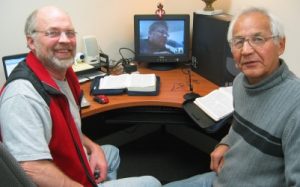 Following several years further north, in 1996 Tim & Ginny Gradin were serving in Prince Albert, Tim as Headquarters bookkeeper. When a missionary couple who had also been involved with linguistics among the Denesuline resigned, Tim wondered if it was time for him to carry on Bible translation.
Following several years further north, in 1996 Tim & Ginny Gradin were serving in Prince Albert, Tim as Headquarters bookkeeper. When a missionary couple who had also been involved with linguistics among the Denesuline resigned, Tim wondered if it was time for him to carry on Bible translation.
He asked Gilbert Bekkatla (who was also living in Prince Albert after serving further north with his wife, Laura) what he thought of him leaving bookkeeping and returning to Dene ministry with a Bible translation focus. Gilbert replied, “I would be willing to give you up to half of my time!”
Tim says that when he realized how important it was for Gilbert to see the Bible translated into his own language, it wasn’t hard to make the switch. Even though Tim didn’t have specialized translation training, he knew there were would be good help available.
When they discussed which book to translate first, they considered NCEM’s more recent emphasis on a “chronological” approach of presenting the Gospel.
The JESUS Movie had been completed in Dene (they’d both worked on it with Bobby Moberly), and the Book of Mark had been published back in 1975 through Bud Elford’s efforts (along with assistants, of course – good translation always relies on local Native speakers).
They knew that there are some big gaps in Dene people’s Scriptural understanding. “We felt that it was important to have a better understanding of who God is, why and how He created the world,” they agreed, “and how He relates to the people He created.”
Gilbert isn’t always able to offer a lot of time, and says he often feels torn between the project, and spending time with Dene people who need to be reached. He loves to share the Good News with them and other First Nations people through home visits, at the mall, in jails, and trips to northern communities.
The Genesis translation project began in 1997 and Gilbert and Tim were later joined by Bobby Moberly who, like Gilbert, is Denesuline. All three men have other ministries including Bible camps, jail outreach, northern trips, and Bobby serves on Key-Way-Tin Bible Institute staff with his wife, Veronica. These all extend the project’s completion date but, as much as possible, they have been devoting two mornings each week.
Internet technology is a big help. Gilbert and Tim meet in Prince Albert and Bobby joins them via Skype video. Like most Dene, Gilbert and Bobby do not read and write their own language easily, so Tim handles the computer input. As they translate verse by verse from English, the three of them discuss accuracy and understanding.
Bobby wasn’t involved with the initial draft, so his input is especially valued as they revise the text. Sometimes he’ll respond with, “That’s great!” Other times, “We need to work on that one.”
“We discuss the context of the Scripture passage, the culture and geography, and how other translations have dealt with it,” explains Tim. “We keep working on it together until we agree on how the new translation will best communicate the message.”
It’s tedious work. But there’s also spiritual refreshing involved, say the men. Sometimes Gilbert and Bobby find themselves saying, “Wow, this really speaks to me!” or, “It’s exciting to be doing this! It helps me to understand this passage better myself” (which previously they’d only read and understood in English).
Please pray for this Scripture translation project. It’s already touching people’s lives, as Gilbert and Tim have shared portions of this new Genesis translation in northern homes. Sometimes the reaction has only been a focus on slight dialect differences. Some Denesuline give guarded reactions because of allegiance to a mainline church. Others have been more positive and express anticipation of the project’s completion.
Adapted from Northern Lights issue #522. Note: some of the locations and involvements of our missionaries may have changed since the original publishing of this article.
The Denesuline
Formerly known by outsiders as Chipewyan, the Denesuline (pronounced “Den-eh-sooh-lee-neh”) live in the area shown on map, and in several Canadian prairie cities.
Belonging to the Athapaskan family of languages, the Denesuline language is very complex. It is closely related to the Navajo language which “Code Talkers” used in WW II (it baffled Allied enemies who couldn’t transcribe it, let alone decode it).
Denesuline has 42 sounds (many of them non-English sounds) and uses tones, clicks, and nasals, which are difficult for an English speaker to decipher.
The language was first put into writing with a syllabic system (developed for the Cree language). It proved inadequate, and in the 1950s NCEM missionaries (with Wycliffe help) developed the Roman orthography system used today.
Schools are now teaching Denesuline, and younger people are gaining literary proficiency. Because many Denesuline adults don’t read their language, Genesis will be available in both audio and print format. There may also be a computer version (where a “bouncing ball” is followed across the text during narration) to aid Denesuline reading skills.
NCEM’s goal in these translation efforts is to see Christ’s Church established among the Denesuline. Presently there are comparatively few born again believers.

